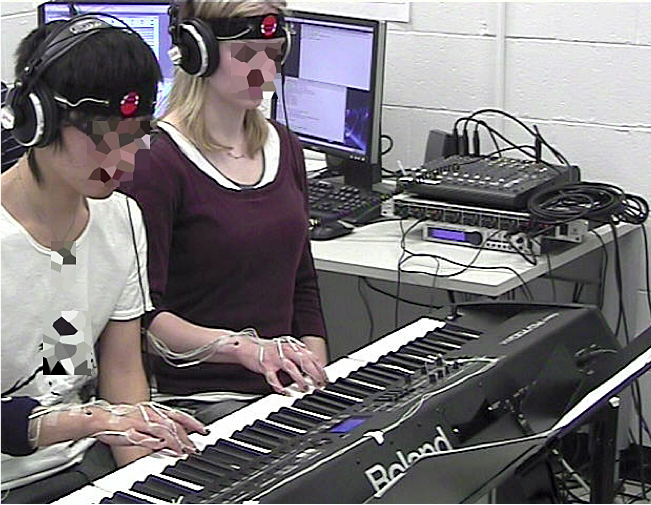Synchronization of timing and motion in piano duets
We investigated influences of auditory feedback, musical role, and note ratio on synchronization in ensemble performance. Pianists performed duets on a piano keyboard; the pianist playing the upper part was designated the leader and the other pianist was the follower. They received full auditory feedback, one-way feedback (leaders heard themselves while followers heard both parts), or self-feedback only. The upper part contained more, fewer, or equal numbers of notes relative to the lower part. Temporal asynchronies increased as auditory feedback decreased: The pianist playing more notes preceded the other pianist, and this tendency increased with reduced feedback. Interonset timing suggested bidirectional adjustments during full feedback despite the leader/follower instruction, and unidirectional adjustment only during reduced feedback. Motion analyses indicated that leaders raised fingers higher and pianists' head movements became more synchronized as auditory feedback was reduced. These findings suggest that visual cues became more important when auditory information was absent. (Goebl and Palmer 2009)
Here were provide supplementary material to accompany the published journal article (Goebl and Palmer 2009).


Figure 1. Motion capture setup for the experiment. The Optotrack Certus motion capture system with active markers (left side) and two participants with the markers glued on the finger tips and ulna of their right hands, and their fore heads (right side). (The data presented below do not necessarily correspond to these two individuals.)
Figure 2. Point-light animation of recorded motion data. Two individuals seen from the front side playing one trial under full auditory feedback together. Two head markers and 6 hand markers are shown for each performer.

Figure 3. Piano roll representation of two individuals performing together under full auditory feedback. Grey notes denote the counting-in metronome. Onset asynchrony between the two players is printed by small numbers. Inclination of the blue lines is magnified to illustrate direction of asynchrony.
For more information about the aims, methods, and results of this project, please see the Goebl and Palmer 2009.
References
Goebl, W., and Palmer, C. (2009).
Synchronization of timing and motion among performing musicians.
Music
Perception, 26(5), 427–438,
doi: 10.1525/mp.2009.26.5.427.

Goebl, W., and Palmer, C. (2008).
Synchronization of Timing and Motion in Piano Duet Performance.
Poster presented at The Neurosciences and Music III – Disorders and Placticity (June 25–28, 2008),
McGill University, Montréal, QC, Canada.
